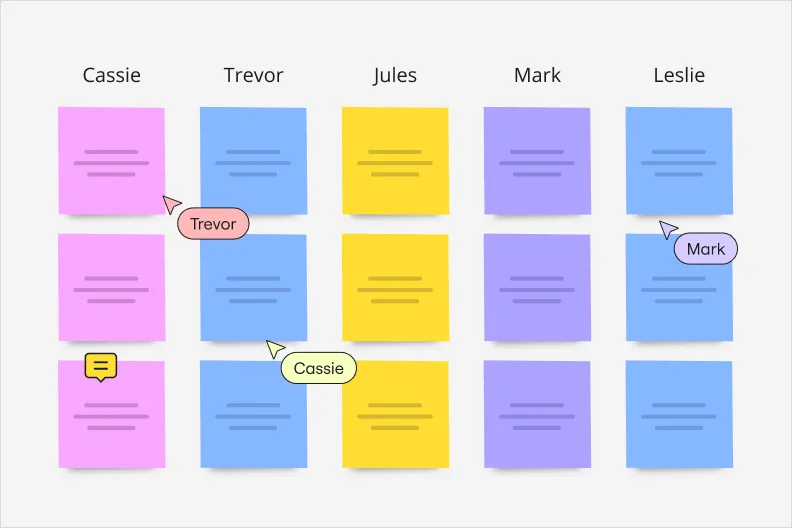Run faster research synthesis

Build stronger products through continuous discovery
Centralize your customer data
Make findings visual, memorable, and easy to understand by centralizing everything onto a single Miro board. Gather user interviews, survey data, recordings, and more from integrated tools like Usertesting, Typeform, and Loom into one shareable workspace.

Bring your stakeholders into the process
Get stakeholders involved from start to finish. With Miro's collaboration tools, teams can discuss findings, align on recommendations, and make data-driven decisions together – or async with Talktrack video walkthroughs.

Streamline your research workflows
Organize, analyze, and synthesize even the largest unstructured datasets. Efficiently cluster themes and summarize findings with Miro AI, allowing more time to deliver impactful insights – even without advanced data skills.

Watch how UX Researcher Deniz runs end-to-end user research projects in Miro

Why people love Miro for research synthesis

Consolidate insights in a single workspace
Contextualize data and UX insights from multiple tools on a single board, through integrations with leading research platforms like UserTesting and Typeform, and BI systems like Amplitude. Bring parts of research from each platform to create a single story.

Connect insights
Find connection points and work on top of data as a team. Align on which elements to include using anonymous voting and discuss findings from multiple stakeholders using clustering. Make data-driven decisions using insights from multiple sources.

Create synthesis seamlessly
Leverage the power of AI to move quickly through analysis. Synthesize large amounts of data across multiple teams, themes, and sources using Miro AI with sticky note summarization and sentiment analysis to speed up decision-making.

Collaborate as a single unit
Teams can collaborate across complex research projects, enabling stakeholders and decision-makers to provide input throughout the process. Record video walkthroughs, leave comments, stickers, sticky notes, and written feedback with reminders delivered directly to everyone’s inbox.
Integrated with your favorite tools

Related pages
Related templates





Tips on how to run insights synthesis

Research and insights synthesis FAQs

Why is research synthesis important?
Research synthesis is crucial because it helps in organizing and making sense of vast amounts of information available in various studies or datasets. It enables researchers and practitioners to identify trends, gaps, and areas for further investigation.
What methods are used for research synthesis?
Common methods used in product discovery research include user interviews, surveys, usability testing, ethnographic research, competitive analysis, journey mapping, and prototype testing. These methods help teams gather qualitative and quantitative data, understand user behavior, identify pain points, and uncover opportunities for innovation.
What are the phases of research synthesis?
Data Extraction: Extract relevant information from each selected study, such as study design, sample size, methodology, findings, and any other relevant data. Organize and catalog the extracted data to facilitate further analysis. Data Analysis: Depending on the nature of the studies and your research questions, you may perform various types of analyses, such as statistical analysis, content analysis, thematic analysis, or meta-analysis (if applicable). Identify patterns, trends, and common themes across the studies. Synthesize the findings of the individual studies to draw broader conclusions or insights. Interpretation and Synthesis: Analyze the synthesized findings to answer your research question or address your research objective. Identify areas of consensus, divergence, or gaps in the literature. Draw conclusions and make recommendations based on the aggregated evidence. Reporting and Communication: Prepare a comprehensive synthesis report that includes the research question, methodology, findings, conclusions, and recommendations. Clearly communicate the synthesis process and results to your intended audience, whether it's a research community, policymakers, practitioners, or the general public. Review and Validation: Have your synthesis reviewed by peers, experts, or colleagues to ensure the accuracy, validity, and reliability of your approach and findings.
How does Miro help my team collaborate on research synthesis?
Miro brings research teams and stakeholders together in one secure, visual workspace. Teams can centralize notes, user feedback, and data sources, before co-creating directly on the infinite canvas.
Real-time and async collaboration features ensure insights stay connected to conversations, too, reducing the need for extra meetings.
Does Miro have research synthesis examples or templates I can use?
Yes. The Miroverse is our community-driven library, housing thousands of templates built and used by other Miro users. This means you never have to start from scratch and can find inspiration quickly.
Can Miro handle large or complex research synthesis projects?
Absolutely. Miro is built to manage research at any scale, from a few interview notes to thousands of data points across multiple teams. Large datasets can be organized, tagged, and synthesized using AI clustering, while over 160 integrations keep everything in sync.
Can I adapt Miro to fit my research workflow for research synthesis projects?
Miro is a flexible, customizable workspace that can be personalized in any way you see fit. Create templates for recurring research methods and reuse them across teams, or use Miro Blueprints for pre-configured Spaces with boards, tools, and formats for specific processes.





